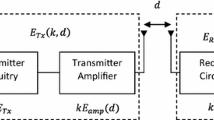Abstract
Miscellaneous issues related to wireless sensor networks (WSN) like clustering of sensor nodes, load balancing amongst the cluster heads, energy efficient multipath routing, prevention of communication failures, storage of information etc. are receiving increasing interest now a days. Hence, addressing these issues with the restriction of computational constraint and limited power supply is a challenging task to be performed. In regard to this, design of energy efficient clustering and routing algorithms have gained proper attention over the last few years because of their contribution towards the appropriate utilization of available energy and extension of network lifetime. In this paper, we propose a quasi dynamic clustering algorithm with an objective to prolong the network lifetime by reducing energy consumption of sensor nodes. Entire set of sensor nodes has been divided into two sets depending upon their proximity to the nearest gateways. Nodes from the first set are assigned to the fixed set of gateways while those from the other set are associated dynamically on the basis of instantaneous network statistics. Performance of the proposed algorithm has been demonstrated by means of extensive simulation studies. It has finally been substantiated that the proposed clustering protocol shows comprehensive improvement with respect to existing algorithms in terms of number of active sensor nodes, network life time, energy consumption etc.






Similar content being viewed by others
References
Jiming, C., Ruizhong, L., & Youxian, S. (2006). Communication system of WSN. Chinese Journal of Sensors and Actuators,19(4), 1290–1295.
Akyildiz, I., Su, W., Sankarasubramaniam, Y., & Cayirci, E. (2002). Wireless sensor networks: A survey. Computer Networks,38(4), 393–422.
Li, Y., Xiao, G., Singh, G., & Gupta, R. (2013). Algorithms for finding best locations of cluster heads for minimizing energy consumption in wireless sensor networks. Wireless Network,19(7), 1755–1768.
Kyung, T. K., et al. (2009). An energy efficient routing protocol in wireless sensor networks. In Proceedings of the international conference on computer science and engineering IEEE (pp. 132–139).
Ameer, A. A., & Mohamad, Y. A. (2007). A Survey on clustering algorithms for wireless sensor networks. Computer Communications,30, 2826–2841.
Boyinbode, O., Le, H., & Takizawa, M. (2010). A survey on clustering algorithms for wireless sensor networks. In IEEE, international conference on network-based information systems (vol. 13, pp. 358–364).
Kuila, P., Gupta, S. K., & Jana, P. K. (2013). A novel evolutionary approach for load balanced clustering problem for wireless sensor networks. Swarm and Evolutionary Computation,12, 48–56.
Antonio, C., Cesana, M., Donno, D. D., & Filippini, I. (2010). Deploying multiple interconnected gateways in heterogeneous wireless sensor networks: An optimization approach. Computer Communications,33(10), 1151–1161.
Younis, M., Youssef, M., & Arisha, K. (2002). Energy-aware routing in cluster based sensor networks. In Proceedings of the 10th IEEE/ACM international symposiumon modeling, analysis and simulation of computer and telecommunication systems (MASCOTS). Fort Worth, TX, USA.
Hussein, O., & Saadawi, T. (2003). Ant routing algorithm for mobile ad-hoc networks (ARAMA). In Proceedings of the IEEE international performance, computing, and communications conference (vol. 22, pp. 281–290).
Ataul, B., et al. (2009). A genetic algorithm based approach for energy efficient routing in two-tiered sensor networks. Ad Hoc Network,7, 665–676.
Bara’a, A. A., & Khalil, E. A. (2012). A new evolutionary based routing protocol for clustered heterogeneous wireless sensor networks. Applied Soft Computing,12(7), 1950–1957.
Gupta, S. K., & Jana, P. K. (2015). Energy efficient clustering and routing algorithms for wireless sensor networks: GA based approach. Wireless Personal Communications,83, 2403–2423.
Issam, M., et al. (2013). Particle swarm optimization for solving engineering problems: A new constraint-handling mechanism. Engineering Applications of Artificial Intelligence,26, 1263–1273.
Kulkarni, R. V., & Venayagamoorthy, G. K. (2011). Particle swarm optimization in wireless-sensor networks: A brief survey. IEEE Transactions on System, Man and Cybernetics, Part C (Applications and Reviews),41(2), 262–267.
Kuila, P., & Jana, P. K. (2014). A novel differential evolution based clustering algorithm for wireless sensor networks. Applied Soft Computing,25, 414–425.
Tyagi, S., & Kumar, N. (2013). A systematic review on clustering and routing techniques based upon LEACH protocol for wireless sensor networks. Journal of Network and Computer Applications,36, 623–645.
Lindsey, S., & Raghavendra, C. S. (2002). PEGASIS: power efficient gathering in sensor information systems. In Proceedings of the IEEE aerospace conference. Big Sky, MT, USA.
Younis, O., & Fahmy, S. (2004). HEED: A hybrid, energy-efficient, and distributed clustering approach for ad hoc sensor networks. IEEE Transactions on Mobile Computing,3, 366–379.
Manjeshwar A., &Agrawal, D. P. (2002). TEEN: A routing protocol for enhanced efficiency in wireless sensor networks. In Proceedings of the 15th international workshop on parallel and distributed computing issues in wireless networks and mobile computing (pp. 2009–2015). San Francisco, CA.
Loscri, V., et al. (2005). A two-levels hierarchy for low-energy adaptive clustering hierarchy. In Proceedings of vehicular technology conference (vol. 3, pp. 1809–1813). IEEE.
Nurhayati, C., Sung, H., & Lee, K. O. (2011). A cluster based energy efficient location routing protocol in wireless sensor network. International Journal of Computers and Communications,5(2), 67–74.
Karp, B., & Kung, H. (2000). GPSR: Greedy perimeter stateless routing. In Proceedings of the sixth ACM international conference on mobile computing and networking (pp. 243–254). Boston, Massachusetts.
Kuila, P., & Jana, P. K. (2012). Energy efficient load-balanced clustering algorithm for wireless sensor network. In proceedings of the 2nd international conference on communication. Computing and Security, 6(1), 771–777.
Author information
Authors and Affiliations
Corresponding author
Additional information
Publisher's Note
Springer Nature remains neutral with regard to jurisdictional claims in published maps and institutional affiliations.
Rights and permissions
About this article
Cite this article
Chandra, A., Parvin, M. Quasi-dynamic Load Balanced Clustering Protocol for Energy Efficient Wireless Sensor Networks. Wireless Pers Commun 111, 1589–1605 (2020). https://doi.org/10.1007/s11277-019-06942-6
Published:
Issue Date:
DOI: https://doi.org/10.1007/s11277-019-06942-6




